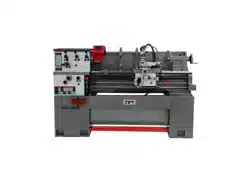Loading ...
Loading ...
Loading ...

16
12. Half Nut Engage Lever (thread cutting) (F,
Fig. 15) – located on front of the apron. Move
the lever down to engage. Move the lever up
to disengage.
13. Cross Traverse Handwheel (G, Fig. 15) –
located above the apron assembly. Rotate
clockwise or counter-clockwise to move, or
position.
14. Compound Rest Traverse Handwheel (H,
Fig. 15) – located on the end of the
compound slide. Rotate clockwise or counter-
clockwise to move, or position.
15. Tool Post Clamping Lever (J, Fig. 15) –
located on top of the tool post. Rotate
counter-clockwise to loosen and clockwise to
tighten.
16. Tailstock Quill Clamping Lever (A, Fig. 16)
– located on the tailstock. Lift up to lock the
spindle. Push down to unlock.
17. Tailstock Clamping Lever (B, Fig. 16) –
located on the tailstock. Lift up lever to lock.
Push down lever to unlock.
18. Tailstock Quill Traverse Handwheel (C,
Fig. 16) – located on the tailstock. Rotate
clockwise to advance the quill. Rotate
counter-clockwise to retract the quill.
19. Tailstock Off-Set Adjustment (D, Fig. 16) –
Two hex socket cap screws located on the
tailstock base are used to off-set the tailstock
for cutting tapers. Loosening one screw while
tightening the other off sets the tailstock.
20. Foot Brake (A, Fig. 17) – located between
stand pedestals. Depress to stop all lathe
functions.
21. Micro Carriage Stop (B, Fig. 17) – located
on the lathe bed. Loosen two hex socket cap
screws underneath body and slide along bed
to desired position. Tighten screws to hold in
place.
22. Main Power Switch (not shown) – located on
the electrical box door on the rear of the
lathe. Turns main power to the lathe on and
off.
11.0 Operation
11.1 Break-in procedure
During manufacture and testing, this lathe has
been operated in the low R.P.M. range for three
hours.
To allow time for the gears and bearings to break-
in and run smoothly, do not run the lathe above
650 R.P.M. for the first six hours of operation.
Figure 16
Figure 17
Loading ...
Loading ...
Loading ...
